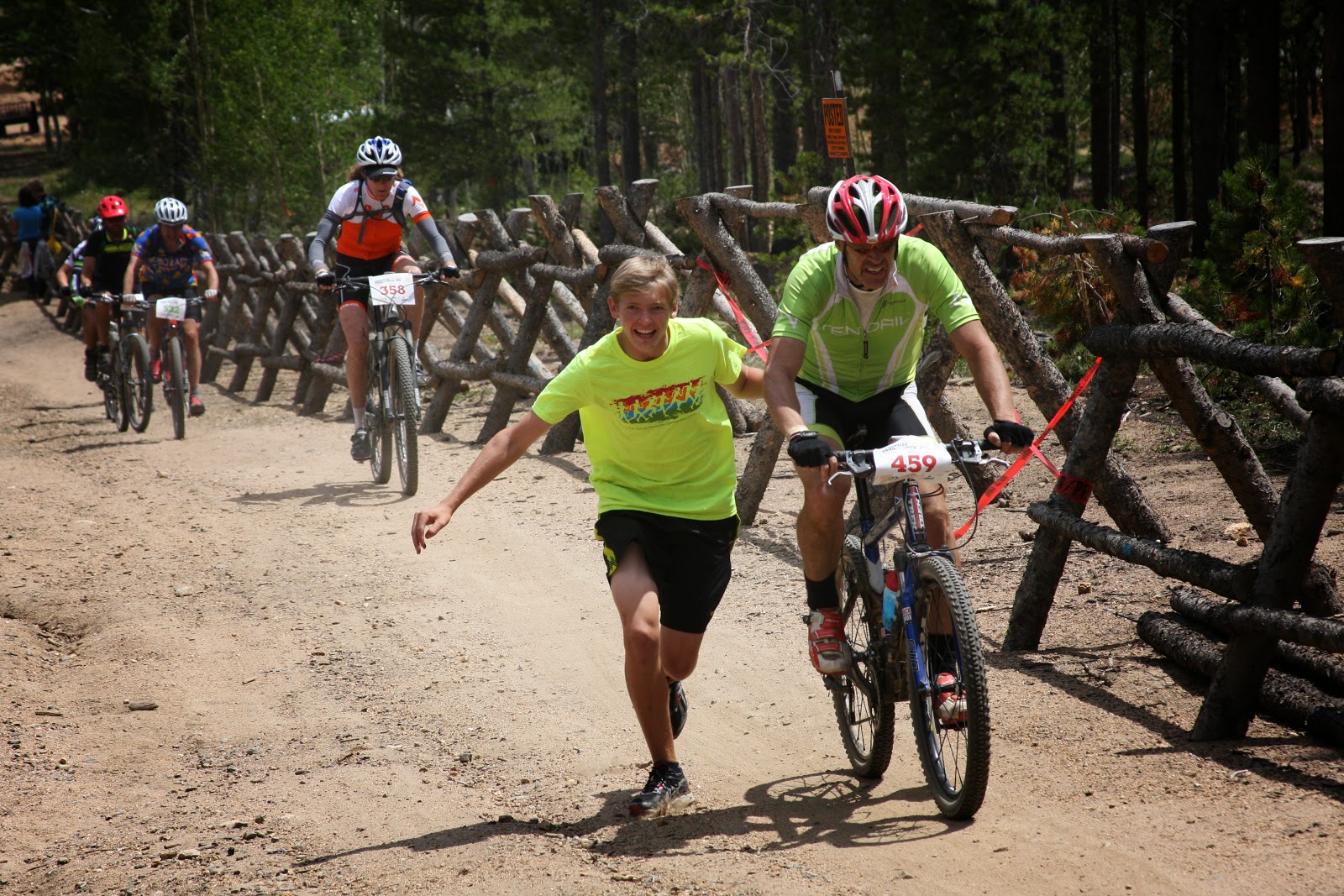 |
| Getting some "encouragement" from my son Derek on the infamous Powerline climb |
This hurt. But it was supposed to hurt. If it didn't hurt I was doing something wrong.
 |
| At the start |
Last year's race was one of the most memorable experiences of my life. This year, while not nearly as momentous proved to be interesting as well. Last year I rode with my brother and we treated it as a team event and stuck together the whole time. This year he was taking the same strategy with his wife Liz. She crewed for us last year and got so pumped watching the event that she wanted to give it a try. I was back to ride it mainly because my son Derek, who crewed for just the last aid station, was excited to crew the entire race. He wanted to see what I could do. My stated goal was to break ten hours, but my real goal was to make Derek proud of me.
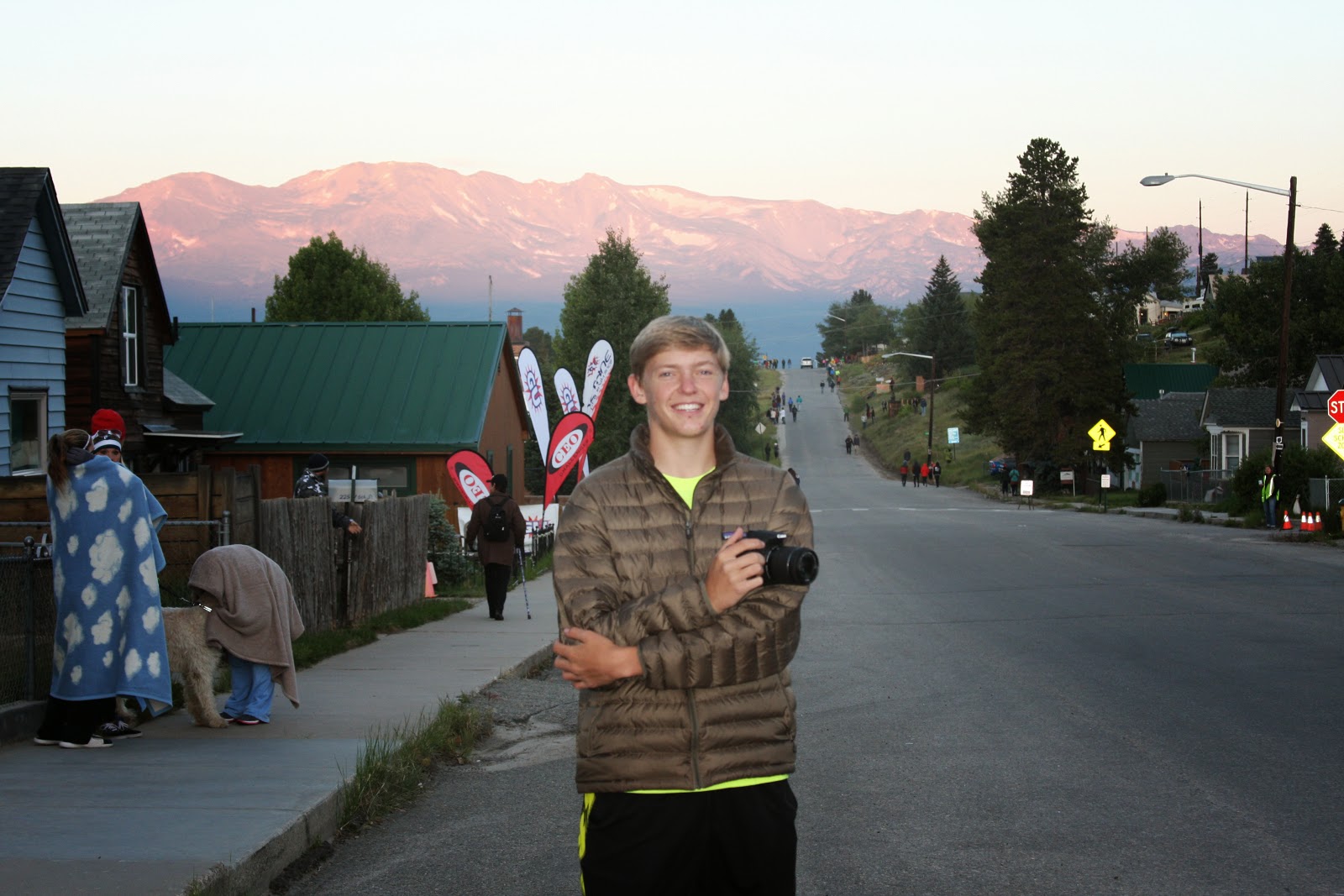 |
| Derek ready to document the race and crew for me |
The race is a mass start, but everyone is queued into corrals with the fastest people in the front, of course. Having finished just barely under 12 hours last year I would have had to start in the third to last corral. But, I raced the
Silver Rush 50 in order to improve my starting position and got moved up to the third overall corral. Chris and Liz had to start at the very back. Chris could have started in the third to last corral but he was a team with Liz, so they started together at the back. I queued right next to my friend Jason. We all rode to the start from our hotel and I was wearing a jacket and knee warmers so that I wouldn't get too cold waiting for the start in the 40-degree temperature. Just before the start, though, I stripped them off and tossed them to Sheri. Chris and Liz did the same with their jackets.
 |
| Off we go |
 |
| Just before the start |
After the national anthem, sung by 7-time winner Dave Weins' son, the gun went off. We didn't move at all for about 30 seconds (it was 4 minutes before Chris and Liz started moving) and then we rolled out. They had made some announcement about a pinch in the course, but I didn't catch it all. Less than a hundred yards from the start the course, which was taking up the entire road, we were pinched to about a third of that width. The entire field came to a stop and it caught me by surprise and I hit my front brake hard to avoid crashing into the guy in front of me. I hit it too hard, without my weight back, and I flipped over the handlebars. This is in a dense crowd with riders within a foot of me on all sides. I was able to get one foot out and got it down on the ground to avoid really crashing, but my right foot remained clipped in and I was tangled up in my bike. One of my bottles fell off and I was making a mess of the start. Yet no one yelled at me. Everyone was cool. I was able to finally twist out of my pedal, collect my bottle and remount. A little ways down the street I went by Sheri and she was surprised I was already way behind Jason. They would be keeping a close eye on our relative locations throughout the race.
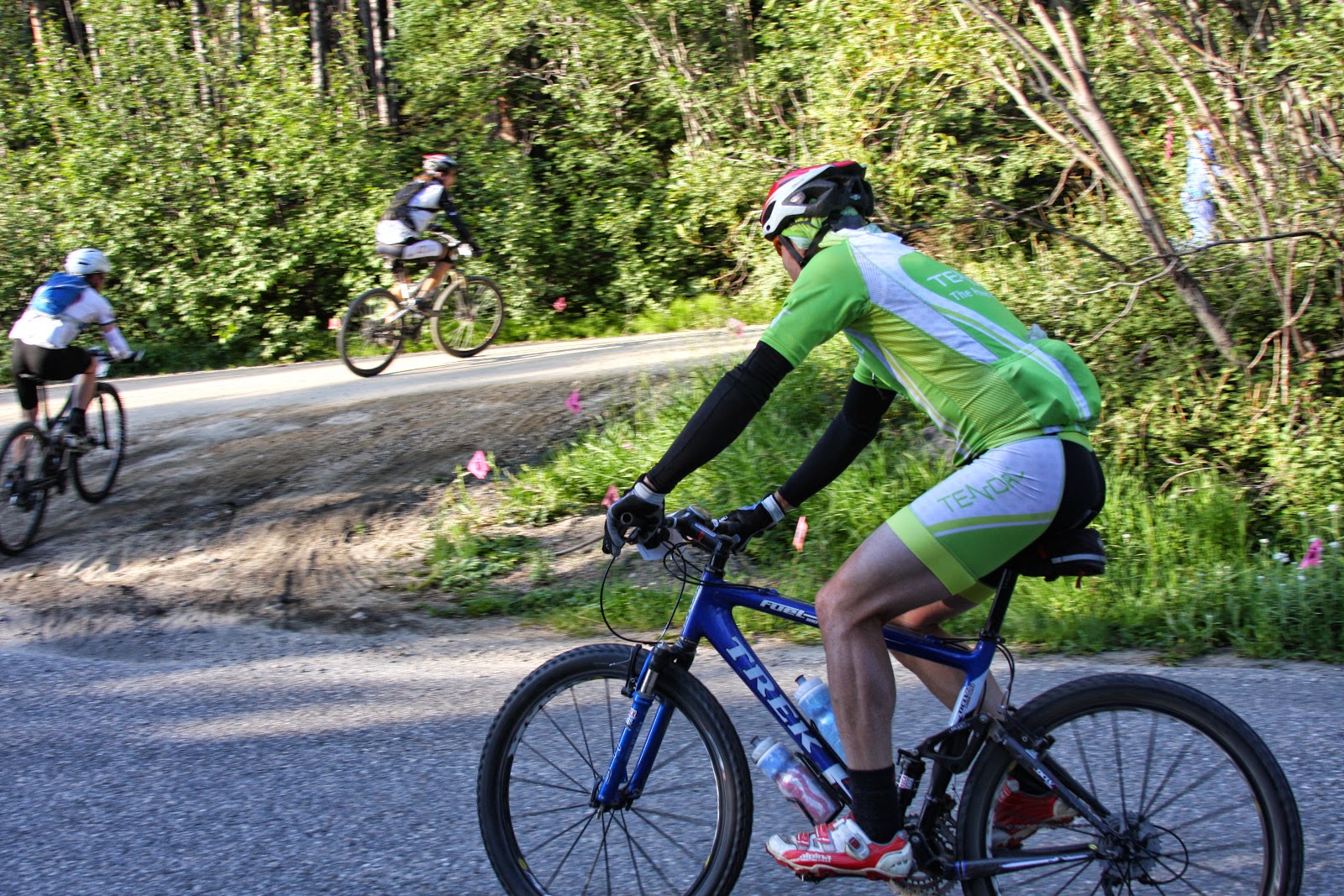 |
| Turning onto Hagerman Pass Road |
 |
| Approaching Hagerman Pass Road |
I tried to maintain position on the four-mile descent and did a reasonable job with this. Some riders went by me and I went by others. I wasn't overly aggressive and got to the base of the St. Kevin's climb in good shape, though with very cold hands. They wouldn't warm up for probably twenty minutes or more. I tried to relax and just keep pace. We were climbing quite a bit faster than last year, due to being more towards the front, but it was still pretty comfortable most of the time. On the steepest section I did top a heart rate of 150 bpm, which was my ballpark limit for the first three quarters of this race. I did a good job with this and only briefly topped it on very steep sections throughout the race.
 |
| My crew, still trying to wake up, apparently |
Things went well on the climb and I rolled through the St. Kevin's aid station without stopping, along with everyone around me. Out on the pavement, I made sure to eat and drink on the three-mile descent. All too soon, we were climbing again, initially on the paved Turquoise Lake Road. At the Hagerman Pass Road turn-off, my crew of Sheri, Derek, and Arthur (Chris' son) were there to cheer me on. They only saw me for a few seconds, but they made the effort to come out to this point and it meant a lot to me. The road was dirt now but smooth for another two miles or so. Then we switchbacked hard to the left onto a much rockier road with a couple of single track paths. I generally held position here, as I was already among riders with similar fitness. This was the Sugarloaf climb and while it is pretty long, most of it is at a very reasonable angle and it is the easiest of the major climbs in the race, save the Carter Summit paved-road climb. At the top I pulled over to pee. At least I was hydrating well.
 |
| Jury-rigging my rear shock. This would last for 85 miles |
The descent of Sugarloaf is fast and generally pretty reasonable, but some riders can really blast it. The problem is that one line is much better than any other line and despite being on a 4WD road, it descends more like a single track. I was able to hold my position well on this descent, as it wasn't that rocky. The lower part is the infamous Powerline section. This is hike-a-bike for nearly everyone on the way back, but it is a fast, dangerous descent on the way out as the track is very narrow and it goes right besides a big groove. If you fall off the narrow track into the groove, you'll crash. There are also some sizable dips. I hit one of these dips hard and heard a loud crack followed by a high-pitched buzzing sound that did not stop. I wondered what I had done to my bike, but I couldn't stop on such a steep, fast descent. Spectators on the sides were saying, "That doesn't sound good." Indeed it did not.
When I got down to the bottom of Powerline, I pulled over and dismounted. I figured I must have a stick stuck somewhere that was rubbing against my tire. It didn't take long to debunk this thought and see that I had, in fact, broken whatever kept my rear shock together. The joint between the arms of the shock was missing a pin to hold them together. If I sat on my bike the frame collapsed until it rested on my back tire. I remember in one Tour de France how the infamous doper Lance Armstrong found the reason he wasn't feeling so strong - his brakes were rubbing against his wheel. Game over, I thought. I stood there, numb, for a bit. I couldn't ride another 85 miles sitting on my tire. Heck, I wondered how long it would be before I wore completely through the tire and if that would be before or after my body gave out from the drag. I'd been thinking about this race all year, yet I wasn't crushed or devastated. Not yet, anyway. I just thought, "Dang. That sucks. I guess I'll be crewing for Chris and Liz now. I even thought, "Hey, Chris doesn't need to finish this race, as he's done it before. Maybe we could tag team the remaining sections, helping Liz." No rider wore any race bib - it was only on the bike. And we are almost the same height. We have different pedals, but almost the same size feet. I'd just put on his shoes and go. I'd be back in a support role, giving all I had to help Liz this time.

 |
| Time-trialing to get onto the back of a big group |
I hopped back on my bike, but it was difficult to ride. I had to at least ride a few more miles. I knew my crew were going to be at an intersection on the way to the Pipeline Aid Station. They were just going to check my progress and cheer as I flew by. Now, I'd be creeping down the road and pulling over. I rode probably a hundred yards, out onto the paved road and then spotted a stick on the side of the road. I stopped and then, after aligning the two arms of the shock, threaded the stick into the joint to hold it together. As soon as I hopped on the bike I snapped the stick. The joint hole was only about a quarter of an inch in diameter so the stick wasn't nearly strong enough. Spectators lining the road could see I was having problems and I called out to the crowd, "I need a metal rod!" I needed a bolt and a nut, really. At home I'd surely have something to hold the fork together, but not many people out watching a bike race has a lot of hardware with them. What were the odds my plea could possibly be answered? I can tell you, it was not zero, because two chicks standing by a white pickup truck said they might have something. I pulled over to the other side of the road and one of the chicks jumped into the back of the pickup. She emerged with a quarter-inch diameter steel bar that was probably five feet long. How the hell would we cut that to three inches long? Before I could even ask, out came a massive pair of bolt-cutters! One of them held the bar and the other snipped off the end. I don't remember giving any instructions, they just swung into action like they'd been repairing rear shocks in race pit stops for years. We threaded it through the joint, but I knew it would eventually bounce its way out of there. No problem. The girls pulled out some duct tape, ripped it into strips and wound it around both ends of the bar. Brilliant. I was back in the game. It was unreal. I went from terribly unlucky to fabulously lucky within the course of ten minutes. I meant to ask them to cut me another length to carry with me because I wasn't sure the duct would be enough, but I forgot. I just thanked them for saving me and I was off. That MacGuyver effort lasted the entire race.
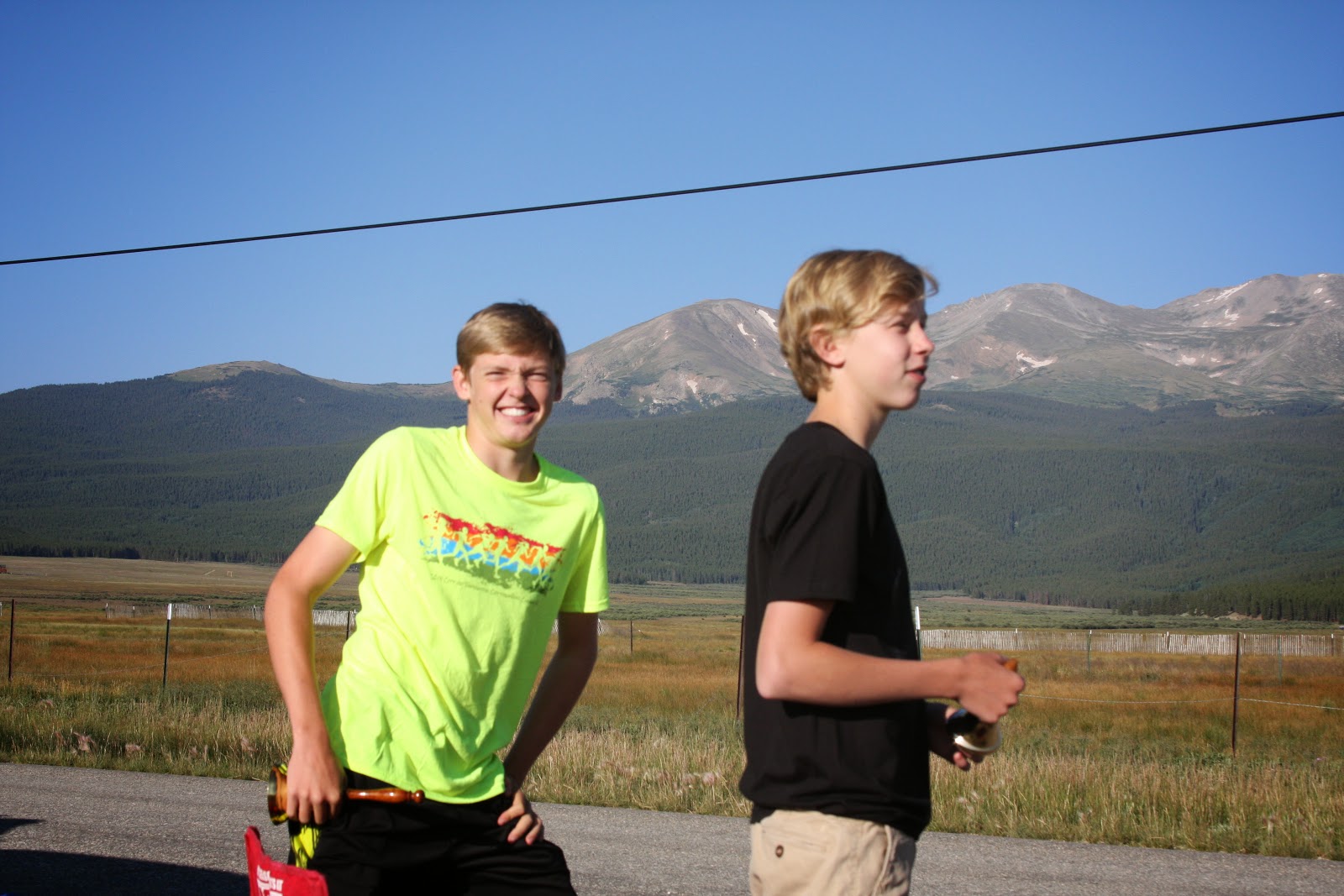 |
| Derek and Arthur - self-proclaimed best cheerers at the race. |
At first I started pushing too hard, cognizant of the time I had lost. Soon I came to my senses. I still had to ride smart to ride for 103 miles. I can't make up that time. It's gone. I just have to do the best I can from here on out. The next four or five miles are all pavement and I teamed up with another strong rider and we took turns trying to catch the big group in front of us. We traded pulls nicely and were closing rapidly. When we went by my crew I was on the front with my forearms resting on my handlebars, in full time-trial mode, drilling it. This last turn got us onto the end of the group, which was 15-20 riders. We weren't there that long when the group started to break up and we were on the back. I pulled out, tapped my TT buddy on the shoulder, and said, "It's breaking up, let's get on the front group." I then pulled us up to the back of that group, which also broke up into two and once again we made the lead group. Shortly afterwards, we turned onto dirt single track and a mile later we came to the Pipeline Aid Station.

 |
| My crew, doing their thing |
My crew wasn't going to be here, since support vehicle traffic made it impossible to crew at both Pipeline and Twin Lakes. This was a minor disappointment to my team, but they made up for that by seeing me on the road and at the Hagerman Pass Road junction. Instead, Chris and Liz's support team was there, since they were going to be on a 12-hour pace and that would just barely give them enough time to make both aid stations. Their crew consisted my 19-year-old son Danny, their daughter Schuyler and my mom. I saw Danny at the start of the aid station and he just told me, "Orange shirts up on the left." For about a quarter mile the course is lined on both sides by crew, race support, and spectators and it's difficult to spot anyone. Danny did a great job spotting me and I spotted him because he was in a day-glo yellow shirt, just like Sheri and Derek. But orange shirts weren't as distinctive. I anxiously scanned the crowd. I just needed fresh bottles here. I spotted them just as I went by and stopped and pulled over a bit ahead of them. I was a bit early, but they hopped on it. Bringing me two fresh bottles. I dumped my empties and was off. Before I got completely clear of the aid station I dropped one bottle. I left it behind. I only had to go 12 miles to Twin Lakes and there was hardly any climbing. I figured one bottle would do fine and it did.
 |
| Twin Lakes outbound. From here I start the huge climb up to Columbine Mine |
I worked at a steady effort, keeping my heart rate in the 140's nearly the entire time. I bombed down the easy, fast descents and was more careful on the winding single track. I came into Twin Lakes at 9:32 a.m. taking just over three hours to cover the first forty miles. My crew was set up just before the race aid station. I had no trouble spotting them at any aid station and they always spotted me, which is quite a trick when everyone looks the same: lycra, helmet, sunglasses. I had on my distinctive light green Tendril kit and they had their incredibly bright yellow shirts. I pulled over and they leapt to action. First, salt tablets. Empty bottles were stripped from my bike and replaced with full bottles. My empty gel flask was pulled from my jersey pocket and replaced with a fresh one. I grabbed an already opened package of Shot Blocks and I was off in about 30 seconds. This team knows what it's doing.
 |
| Chris and Liz getting to Twin Lakes outbound just a few minutes before the cut-off time |
 |
| Chris and Liz's crew of Schuyler, Nana, and Danny |
I was off onto the toughest section of the race - the 3400-foot climb to the course high-point at 12,600 feet at the Columbine Mine. The course rolls over a couple of minor bumps before starting up for good on a relatively smooth fire road. The only problem with this climb is that it's 3400 feet long! This climb wore me down. I passed some people. Some people passed me. I knew it was ten miles from the aid station to the turn-around and I watched the miles tick by on my handlebar-mounted GPS watch. I knew the last three miles involved a good dose of hike-a-bike and I got to the point where I was craving that section. Not only because it indicated I was getting closer to the top, but also to give me an excuse to get off my bike and walk a bit. I was pretty wasted. When the pushing started I only pushed for a quarter mile before I could ride again, but then only rode a quarter mile before pushing another quarter. I rode some more and then pushed a third of a mile. The last half mile or so is all rideable and the course actually descends about a hundred feet to the turn-around. I rode through here without stopping at all. I rode back to the high point and bit further to start the very steep descent and stopped briefly to pee and put my glasses on. I did the climb in an hour and fifty minutes.
 |
| Returning to Twin Lakes and headed for home |
The Columbine-Mine descent is fast, rocky, and demands your complete attention. Out-bound riders are all pushing up on the left and descending riders must stay right, no matter what the terrain is like. This requires riding through some very rocky terrain. On my nearly hard-tail/hard-front bike this was jarring. I had to stay focused and not make any mistakes. If I crashed it would likely be into the walkers. I was one of the few race riders on a 26er with V-brakes and this descent was the only section of the course where I really wished I was riding a 29er with disc brakes. Alas, this is only ten miles of the course. Yes, my bike is old. Yes, the front fork doesn't work very well. Yes, the rear suspension broke. But this is an all-carbon, Trek Fuel 100 XC race bike that weighs just 23 pounds. In a race with 12,600 feet of climbing, I valued that lightness.
Once I got back to the fire road I started scanning for Chris and Liz. I was descending at 20-30 mph except for the hairpin turns and passed a few riders descending more cautiously and tried to stay with riders descending more aggressively. I was cautious in the turns, knowing it is easy to dump here, but I let it rip on the straights. The lower I got the more worried I got about Chris and Liz. I eventually went by Liz and she spotted me before I spotted her. I went flying by her, but I could tell she was smiling and climbing great. But Chris wasn't with her… After the next switchback I spotted Chris and yelled out. He also wore a grin and seemed to be doing well. Later I'd fine out that he had a couple of bonking issues, but was able to bounce back. I wondered how close they were to the cut-off times. It turned out that they barely made the cut-off to climb up to Columbine Mine. They thought it was so close that they blew right by their support, which was set up before the official checkpoint which they had to cross in just a few minutes. This turned out to be a mistake, but an easy one to make in the heat of the moment when you think you need to do everything to make the cut-off time. Once through the checkpoint they could stop and get water and food from the aid station, but not all the goodies they had planned to pick up. The crucial thing they were missing was their rain gear and they started up the monster climb without it. This was a dangerous mistake, but I wasn't the only Wright having luck on the course.
 |
| My crew waiting for me to arrive back at Pipeline |
As they neared the top, the rain started. At first, Liz thought, "Ah, this is nice. It will cool me off a bit." Little did she know how much it would cool her off. By the time they arrived at the top it was a full-blown hail storm that threatened anyone without storm gear with hypothermia. They shivered under the only tent at the top, but the wind was so strong that they couldn't escape the onslaught. Liz was going downhill fast, freezing there at 12,500 feet. A race volunteered noticed her condition and offered his vehicle - the only one at the summit. They both jumped into the heated car and waited fifteen minutes for the storm to pass. Liz was still dangerously cold and had to shed her top clothing for a dry layer. Where she got this layer, I don't know. This time in the car cost them. When they got back down, they were over the cut-off time, but the officials knew about the storm up high and let them continue.
I buzzed into Twin Lakes aid station around 12:05 p.m. and now I had both crews helping me, including Chris's friend Norton. As I pulled up, they went to work with the tasks they knew had to be done and asked me, "What do you need?" I immediattely responded, "Lube!" My chain, though meticulously lubed before the start of the race, had started squeaking on the climb up to Columbine and I heard it all the way down as well. Norton and Derek instantly had lube in their hands and Norton and his son expertly applied it. I never heard a peep out of my chain for the remainder of the race. I took some food with me, had a couple of gulps of chocolate milk, and I was off in leas than a minute. I had to ride the 12 miles back to Pipeline Aid Station, over three significant climbs. This first was a paved road and went fine. After descending a dirt road, I turned hard left and started climbing the single track. One rider pulled over and I went by. No one caught me from behind but many riders were in sight. This race is huge, with 2000 starters, and at my pace the racers were still pretty thick this far into the race.
A mile or so after the single track is a super steep hill, probably the steepest section of the entire course, including Powerline, but it isn't that long. Last year, with tons of power left, I rode it. This year that thought never entered my mind. I dismounted at the bottom, along with every other rider near me. As an aside, the next day I spoke with Todd Wells, the winner of the race, and he told me that he rides everything. Columbine, Powerline, everything. While some of these climbs would probably tax my technical abilities, it is the fitness to climb something so steep for so long that amazes me. I could ride Powerline, I think, if I could stop about a hundred times to rest. Oh, and if there was some way to get started again.
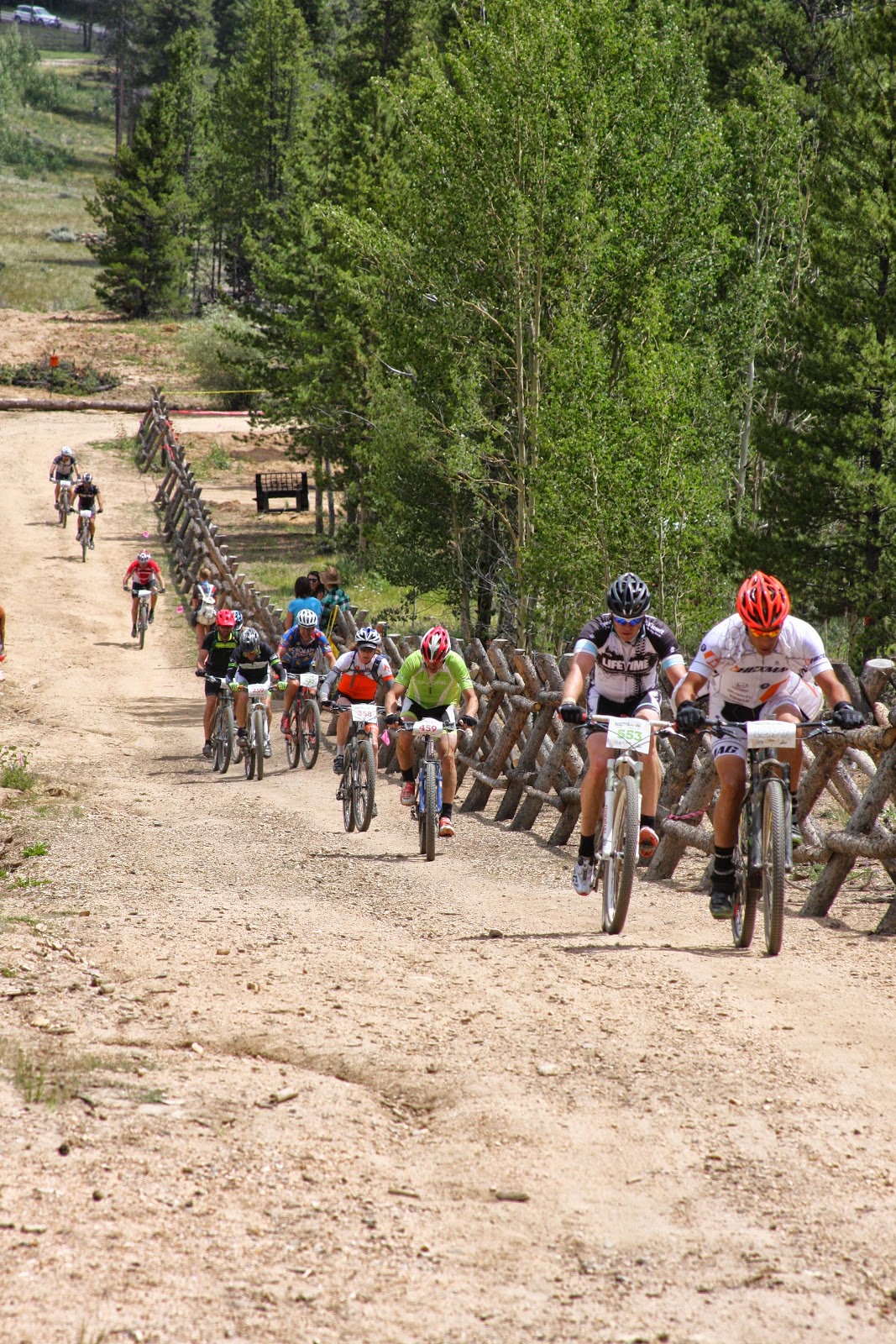 |
| Starting up the dreaded and awful Powerline climb |
When I rolled into the Pipeline Aid Station after 72 miles or so, I was fading. My biggest pain, and it would plague me until the finish line, was my right foot. For some reason it hurt, badly. I wanted to stop and massage it, but I didn't. Once again, my crew took care of me. I took two bottles again, as I knew the horrible Powerline climb was coming next. Sheri urged me to eat more, but I couldn't do much here. She forced me to eat a few chips and Derek fed me part of a Honey Stinger waffle and then I was off. I had to go. Other riders streamed by me while I was stopped and I wanted to be with a group for the next road section.
I worked hard on the trail section immediately after the aid station. I was in my big ring pounding hard to get on the back of a group. I jumped out onto the road right in front of a pickup truck that had wisely stopped, stood up, and sprinted for the back of the group. I got on and that was good, because we now suffered through a horrible crosswind out of the west. The lead rider rode the white line, putting the rest of us in the gutter with no draft. I don't know if he knew what he was doing or not. Maybe no one would pull through. Either way it was brutally hard staying on the group, but I knew in a couple of miles we'd turn directly west and then I'd get a draft. I just had to stay on, which I barely did. Once we turned the corner, though, the wind shifted again, now coming from the north - along crosswind. A new leader went to the front and he too rode the white line, but now, because of the wind direction, we could form an echelon out to the yellow line, which we did. The leader pulled nearly the entire time going west and four of us formed an echelon out to the yellow line. Since the roads were not closed, we were not supposed to cross the yellow line and here, unlike some other riders on different parts of the course, we obeyed. The pace wasn't very hard, but no one pulled through to help the leader. Rotating in an echelon is more complicated than a normal pace line and maybe no one knew what to do. If I had been pulling and no one pulled through to give me some help, I'd have moved over against the yellow line or drifted back.
 |
| Derek and Arthur running with me and pushing me at the start of the Powerline climb |
We made another turn, this time to the north, and I got some more draft, but as we closed against the mountains, the wind eased a bit. We climbed a hundred feet or so and then descended to the hard left turn back onto the dirt, back to the scene of the rear shock breakage. After a quarter mile, I turned hard left, to the west, and started Powerline. I was very tired and dreading this climb. I knew my crew had planned to meet me here for "encouragement". I looked up the hill and spotted the yellow shirts immediately. My first thought was, "Yeah, they made it here," but quickly it went to, "dang, they are so far up there." I switched into my smallest chain ring and spun my lowest gear, creeping slowly up the hill. My crew was cheering loudly. All race long Derek and Arthur would cheer on every rider in such an enthusiastic manner that most riders acknowledged them. Jason sure did and said he got a big power boost from them. When I got to Derek he started pushing me. It felt so good. We moved up fast on the riders in front of me, passing two on the right. I felt guilty for the push, but not quite enough to ask him to stop. Derek turned me over to Arthur and he gave me a small push and then Derek went again and we passed another rider. It was tremendous. Sheri jogged along beside me and gave me updates on Chris and Liz, though they didn't know that much.
 |
| I start mixing in the hike-a-bike minutes after this photo taken |
Chris and Liz had continued their race back to Pipeline Aid Station. The cutoff time there is only an hour later than the cutoff time at Twin Lakes. If you barely make it at Twin Lakes, you have no chance of making the cutoff at Pipeline, as I barely did that section under an hour and they were on a pace that was 2+ hours slower. They did great riding the tough hills back to Pipeline but by the time they arrived it was well past even the newly relaxed cutoff times and they were pulled from the race. Pulled after nearly 75 miles. I think it was an odd mixture of disappointment to be pulled and relief that they didn't have to suffer for 4+ more hours to get over Powerline and then Carter Summit and then the Boulevard. A couple of guys from Wisconsin heard them making plans with Schuyler for her to return to the hotel and come back with the SUV with the bike rack and they offered to give them a ride. It turned out that these guys had seen the video of the 2013 race that I made and knew all about Chris' epic crash in the final quarter mile of the race.
Very soon after Derek stopped pushing me, I had to dismount and start pushing my bike. Everyone around me pushed this section and most riders in the race push it, though, as I've already stated, not the top riders nowadays. Back when Dave Weins was winning this race, he almost always pushed his bike up this section, so there is no shame doing the same. It's brutally steep and all of us bent to the task. Lots of spectators were on the hill. One woman was dressed all in red, with horns and a pitch fork. I said, "Nice costume," and she responded, "Well, aren't you in hell?" Yes, I was. The climb up to Sugarloaf's summit is a nearly never-ending series of false summits. Every one looks like it will be the end, but I'd been here before and knew I'd be on the climb for an hour. Even then I hoped the penultimate summit was the top, only to see it was not. Above the mandatory hike-a-bike at the bottom, it was a series of ride, then hike, ride, then hike. Once again, last year I rode all of this. This year I hiked lots of it.
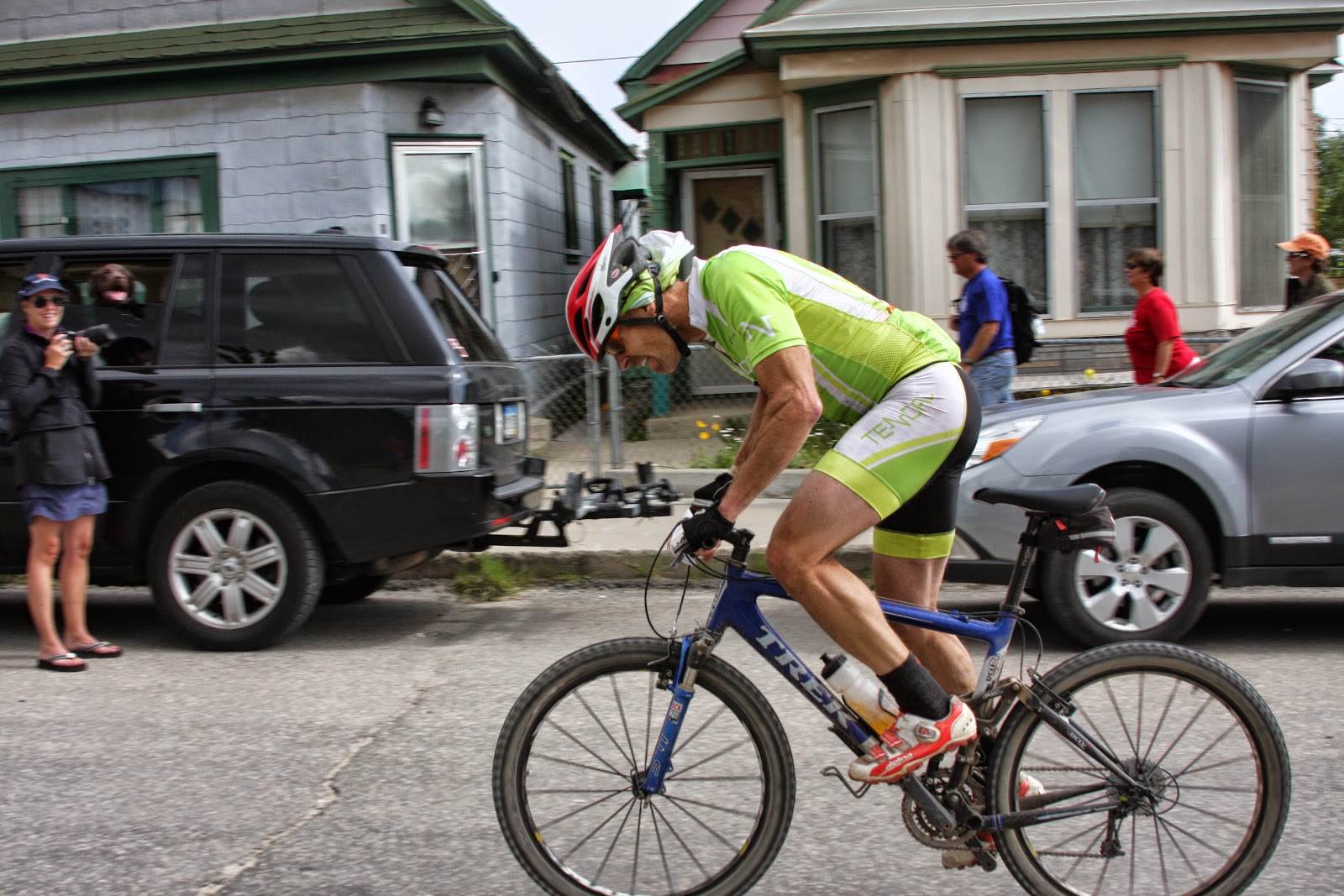 |
| Sprinting with all I've got in the final quarter mile |
The top and start of the descent was glorious. I'd have a heads-up descent to the smooth dirt road and then a fast, easy descent down that and then the pavement before starting the Carter Summit climb, the last major climb. Once on smooth ground I made sure to eat and drink while still going 20+ mph. At the turn onto the pavement I saw my crew. I dumped an empty bottle here and was careful not to crash. I heard Sheri yell, "You are two minutes behind Jason." She'd been giving me updates on Jason's position since Twin Lakes. I was four minutes back then. Five minutes at Pipeline. More than six minutes at the bottom of Powerline. Each time she gave me an update I thought, "I'm not racing him. I'm doing all I can out here and I can't up the effort, not this far from the finish anyway." But I'd obviously made up time on him on Sugarloaf and now I was interested. I was feeling stronger and worked at a steady pace up the 3-mile climb to Carter Summit, all on a paved road. I passed some people, but one or two passed me as well. I passed Jason a mile into the climb and went by very close, but had no breath to talk or encourage him. Instead, I ran the calculations in my head. I gained two minutes on him in a mile of climbing. I had two miles of climbing to go. I could put four minutes on him before the descent of St. Kevin's. I figured he was a faster descender and the splits would later confirm this.
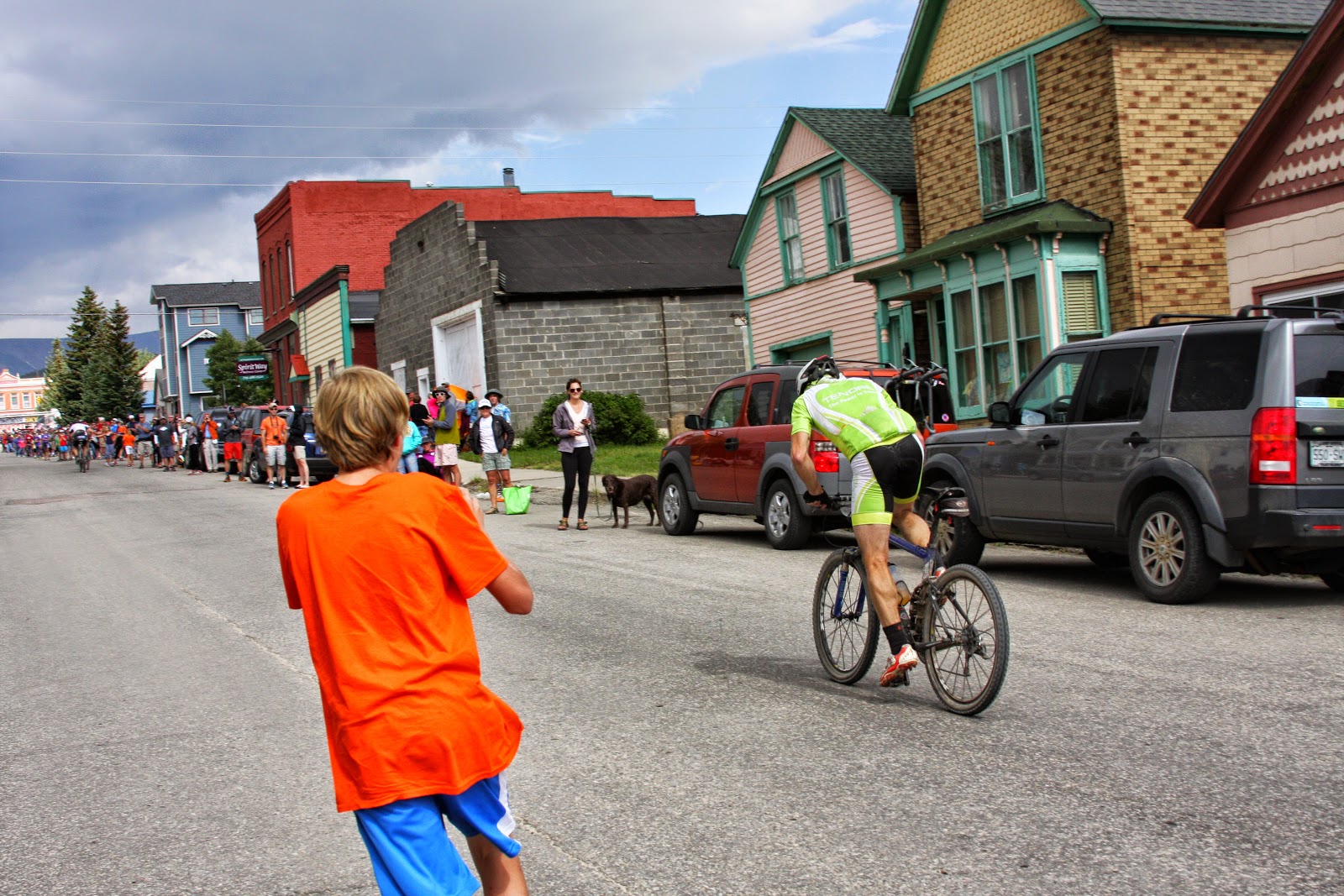 |
| At the far left you can see the finish and a rider (really two) that appear to be close to the finish. I get them both. |
I worked hard on this climb and wasn't discouraged by the length, like I was last year. This time I knew how long it was going to be and I counted off the tenths of a mile and didn't look prematurely for the top. At the aid station I stopped for twenty seconds to get half a bottle water for the 13 miles to the finish. I knew there was 15 more minutes of rolling, climbing terrain before the final descent and I knew two of these climbs were extremely steep, though less than a minute of effort. I rode everything, passing a couple of riders and started bombing the descent. I descended this winding, dirt road at an average of 22 mph. The fastest time for this section (at least on Strava) is by the Leadville course record holder and is 32 mph! At the bottom I caught some riders on the flat. My strength on the mountain bike is the flats, it seems. It's the only place that I consistently catch riders. I caught a rider and went by, telling him to get on and we'd get the two in front, which we did. I rode with these guys for a bit, but I could go harder and I left them and bridged up to another rider. He looked good and I told him to work with me. Another rider joined us and I got us working in a 3-up rotation.
 |
| My awesome crew: Arthur, Sheri, and Derek |
At the start of the Boulevard, a demoralizing two-mile climb on a dirt road, one rider cracked and went off the back. The other started to cramp and I went by. I'd fought cramps a couple of times in the last two hours, but would just ease off the effort and they would go away. This late in the race, that's the only thing you can do. I caught and passed another rider, feeling pretty strong and going hard, catching other riders. As I passed one rider, a group of three riders came up on me and I got on the back of the train. With a half-mile of dirt before the final mile of rolling pavement, the lead rider took off. The other two tried to respond and I was gapped. I couldn't go. I maintained my effort. The lead guy never came back, but I caught the other two as we started the pavement up a nasty little hill. By the time we got to the top I was dropped again. We headed downhill now, over a tiny rise and then had the quarter mile uphill finish. My crew was on the left cheering me on and once I hit the bottom of that hill, I stood and kicked with absolutely everything I had. The other two riders were maybe a hundred feet ahead of me, but I was going much faster. I pounded the pedals and pulled hard up the backside of the stroke. My head was bent down over my bars, only looking up briefly to eye my quarry. The other two entered the chute of fans with arms outstretched to get high fives, but they had to pull back because of the freight train steaming towards them. Maybe it was silly to finish so hard, but there was the line and there were two riders in front of me. I can't resist that. I passed one of them on the left, then had to zig right and I got the other guy four feet before the line.
 |
| The ever-amazing Nana out crewing all day long |
I almost ran over Merilee, founder Ken Choulber's wife, who was standing there passing out finishing medals, as I was still going about 20 mph. I veered right past her and hit the brakes stopping further up the hill. I collapsed over my bars and heaved deeply sucking in huge quantities of air, shifting it for the rare oxygen molecules I so badly needed. It was a full minute before I could look up. I finished in 9h33m. Well under my goal of ten hours, but miles from the coveted sub-9-hour mark that earns you the gold buckle. Still, it was all I had. I never bonked and I paced it pretty well. My crew was amazing and so was the weather and the course. Hence, that's all I got. No excuses. I was quite satisfied with the result.
 |
| Derek and Schuyler |
I had to ride back to the hotel and getting back on the bike was tough, but once up the little hill, I felt fine soft pedaling there. Sheri greeted me as I arrived and we embraced. I didn't see her after the finish because of the crowds and she was waiting to see Jason finish. I waited quite awhile at the finish and Arthur found me, but I never saw Jason. I know he finished about ten minutes behind me. That night we went out to a big steak dinner and retold the stories of the day. It was a great weekend. The next day, after picking up my buckle and jacket, was payback time for my crew. While Sheri and Danny went to climb LaPlata, Derek, Arthur, and I climbed Mt. Princeton. At 14,197 feet, Princeton is the 20th highest summit in the state. Danny had already climbed it and Derek needed to catch up (same thing with LaPlata for Danny). It was Arthur's first 14er. By then I was feeling fine and we did the roundtrip in just over three hours. Recovering from bike races is much easier and quicker for me than from running races.
Speaking of running, now that Leadville is over, I'm switching back to running to get ready for the 10th annual Rattlesnake Ramble! Come on out and run it with me!
 |
| The entire crew |






















































